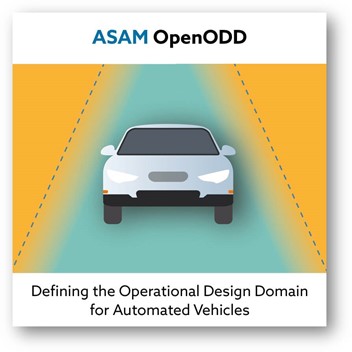
An operational design domain (ODD) is fundamental to the safety of connected and automated vehicles (CAV): it describes the specific operating conditions under which the CAV can be safely deployed. ASAM has now published the concept for a future standard for defining ODDs: “ASAM OpenODD” will specify a language concept and a machine-readable format so that the ODDs can be clearly defined and shared by different users. The aim is also to contribute to better cooperation between vehicle manufacturers and authorities and to accelerate the approval of automated driving functions.
The concept paper can be downloaded free of charge. Additional use cases or requirements can be suggested before standard development begins.
Höhenkirchen (February 8, 2022) – Safety is fundamental to the development of connected and automated vehicles (CAV) and the realization of automated driving (AD). On the one hand, this means that a strict validation process for AD functions is required. On the other hand, it is also necessary to define operating conditions under which a vehicle can be used safely. These operating conditions include parameters such as road type, weather conditions, traffic conditions, time of day and many others that can affect a CAV’s behavior. This safe operating area is defined in the Operational Design Domain (ODD). The ODD is therefore an important part of a vehicle’s safety concept and must be valid for a specific configuration of the automated driving function throughout its entire service life.
For the automobile manufacturer, the ODD is important because it determines which scenarios a CAV is exposed to and thus against which scenarios a driving function or the CAV must be validated. The ODD helps to focus the limited validation resources on the necessary and relevant scenarios. For example, if the ODD excludes driving speeds in excess of 50 km/h or driving on freeways, vehicle manufacturers can adjust their catalog of test scenarios accordingly and neglect tests at higher speeds on freeways.
ODD definitions are particularly important for simulation-based testing. Standards are needed that allow stakeholders to exchange, compare and reuse ODD definitions. This is where ASAM OpenODD comes into play: The standard will provide a machine-readable format that can represent a defined ODD for testing in simulations and other machine-processing environments. In addition, the format is intended to be searchable, interchangeable, extensible, reviewable, and human-readable so that it can be used for all other post-processing steps as well. In this way, ASAM OpenODD will contribute to ADAS and autonomous driving systems not only being able to be developed safely, but also quickly, efficiently and reliably.
Another application example for the effective use of ASAM OpenODD is the cooperation between authorities and manufacturers of CAVs: A city administration can describe the ODD for its city area in ASAM OpenODD format and make it available to the automobile manufacturers. The manufacturers can then compare their vehicles with the defined ODD and thus find out whether their vehicle is allowed to drive in the respective city area. In addition, they can use the descriptions to adapt their scenario test catalog to the requirements of the ODD. The supervisory authority has the advantage that they can check the ODDs and use them for the approval of autonomous vehicles.

Dr. Siddartha Khastgir from WMG, University of Warwick, and leader of the ASAM OpenODD working group comments: “Defining the Operational Design Domain (ODD) is key to the development of a safe automated vehicle. How an ODD is defined is – to this day – still has not been officially established. The concept for ASAM OpenODD lays the foundation for a language for defining ODDs. This means that CAV manufacturers can define and exchange ODD definitions in the future and that the authorities have a common understanding of the ODD definition I am grateful to all international experts who contributed to this work. Achieving the safety of automated driving must be a collaborative effort and ASAM OpenODD is an example of that.”
Peter Voss, Managing Director of ASAM e.V., adds: “ASAM OpenODD will be a standard that not only contributes to the safety of automated vehicles, but above all helps to implement automated driving functions faster.”
In addition to format and syntax, the concept for ASAM OpenODD also takes into account attributes (using ISO 34503), metrics and the representation of uncertainties. The future standard will be compatible with all other standards of the ASAM OpenX family, in particular with ASAM OpenDRIVE, ASAM OpenSCENARIO and ASAM OpenXOntology.
The ASAM OpenODD initiative takes into account and complements the ongoing international standardization activities of the BSI (BSI PAS 1883 – describes a taxonomy for ODDs) and the ISO (ISO 34503 uses the taxonomy to provide a high-level definition format for ODDs for use by regulators, systems engineers , local authorities, etc.). All three projects are in close contact.
So far only the concept of ASAM OpenODD has been published. The working group to develop the standard is expected to start work in April 2022. Potential users of a future standard are specialists in development, simulation, testing, security, data analysis, scenario editors and data labeling as well as infrastructure managers.